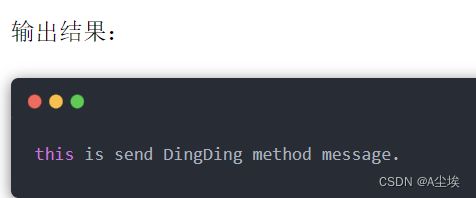SpringBoot——常用注解
Spring Web MVC与Spring Bean注解
@Controller/@RestController
@Controller是@Component注解的一个延伸,Spring 会自动扫描并配置被该注解标注的类。此注解用于标注Spring MVC的控制器。
@Controller
@RequestMapping("/api/v1")
public class UserApiController{
@Autowired
private UserService userService;
@GetMapping("/users/{id}")
@ResponseBody
public User getUserById(@PathVariable long id) throws UserNotFoundException{
return userService.findOne(id);
}
}
@RestController是在Spring 4.0开始引入的,这是一个特定的控制器注解。此注解相当于@Controller和@ResponseBody的快捷方式。
当使用此注解时,不需要再在方法上使用@ResponseBody注解。
@RestController
@RequestMapping("/api/v1")
public class UserApiController{
@Autowired
private UserService userService;
@GetMapping("/users/{id}")
public User getUserById(@PathVariable long id) throws UserNotFoundException{
return userService.findOne(id);
}
}
@RequestMapping
对请求处理类中的请求处理方法进行标注,主要用途是将Web请求与请求处理类中的方法进行映射。
Spring MVC和Spring WebFlux都通过RquestMappingHandlerMapping和RequestMappingHndlerAdapter两个类来提供对@RequestMapping注解的支持
- value:映射的请求URL或者其别名
- method:兼容HTTP的方法名
- params:根据HTTP参数的存在、缺省或值对请求进行过滤
- header:根据HTTP Header的存在、缺省或值对请求进行过滤
- consume:设定在HTTP请求正文中允许使用的媒体类型
- product:在HTTP响应体中允许使用的媒体类型
【提示:在使用@RequestMapping之前,请求处理类还需要使用@Controller或@RestController进行标记】
@Controller
public class DemoController{
@RequestMapping(value="/demo/home",method=RequestMethod.GET)
public String home(){
return "/home";
}
}
@RequestMapping还可以对类进行标记,这样类中的处理方法在映射请求路径时,会自动将类上@RequestMapping设置的value拼接到方法中映射路径之前,如下:
@Controller
@RequestMapping(value="/demo")
public class DemoController{
@RequestMapping(value="/home",method=RequestMethod.GET)
public String home(){
return "/home";
}
}
@RequestBody
在处理请求方法的参数列表中使用,它可以将请求主体中的参数绑定到一个对象中,请求主体参数是通过HttpMessageConverter传递的,根据请求主体中的参数名与对象的属性名进行匹配并绑定值。此外,还可以通过@Valid注解对请求主体中的参数进行校验。
@RequestController
@RequestMapping("/api/v1")
public class UserController{
@Autowired
private UserService userService;
@PostMapping("/users")
public User createUser(@Valid @RequestBody User user){
return userService.save(user);
}
}
@ResponseBody
会自动将控制器中方法的返回值写入到HTTP响应中.
@ResponseBody注解只能用在被@Controller注解标记的类中。如果在被@RestController标记的类中,则方法不需要使用@ResponseBody注解进行标注。@RestController相当于是@Controller和@ResponseBody的组合注解
@ResponseBody
@GetMapping("/users/{id}")
public User findByUserId(@PathVariable long id) throws UserNotFoundException{
User user = userService.findOne(id);
return user;
}
@PathVariable
将方法中的参数绑定到请求URI中的模板变量上。可以通过@RequestMapping注解来指定URI的模板变量,然后使用@PathVariable注解将方法中的参数绑定到模板变量上。
@PathVariable注解允许我们使用value或name属性来给参数取一个别名
模板变量名需要使用{ }进行包裹,如果方法的参数名与URI模板变量名一致,则在@PathVariable中就可以省略别名的定义。
@GetMapping("/uers/{id}/roles/{roleId}")
public Role getUserRole(@PathVariable(name="id") long id,@PathVariable(value="roleId")long roleId)throws ResourceNotFoundException{
return userRoleService.findByUserIdAndRoledId(id,roleId);
}
@RequestParam
用于将方法的参数与Web请求的传递的参数进行绑定。
使用@RequestParam可以轻松的访问HTTP请求参数的值
该注解的其他属性配置与@PathVariable的配置相同,特别的,如果传递的参数为空,还可以通过defaultValue设置一个默认值。
@GetMapping
public Role getUserRole(@RequestParam(name="id") long id,@ReuqestParam(name="roleId")long roleId)throws ResourceNotFoundException{
return userRoleService.findByUserIdAndRoleId(id,roleId);
}
//如果参数为空设置默认值
@GetMapping
public Role getUserRole(@RequestParam(name="id",defalut="0") long id,@RequestParam(name="roleId",default="0")long roleId){
if(id==0||roleId==0){
return new Role();
}
return userRoleService.findByUserIdAndRoleId(id,roleId);
}
@ModelAttribute
通过此注解,可以通过模型索引名称来访问已经存在于控制器中的model。
与@PathVariable和@RequestParam注解一样,如果参数名与模型具有相同的名字,则不必指定索引名称
@PostMapping("/users")
public void createUser(@ModelAttribute("user") User user){
userService.save(user);
}
如果使用@ModelAttribute对方法进行标注,Spring会将方法的返回值绑定到具体的Model上。
@ModelAttribute("ramostear")
User getUser(){
User user = new User();
user.setId(1);
user.setFirstName("ramostear");
user.setEmail("[email protected]");
return user;
}
【在Spring调用具体的处理方法之前,被@ModelAttribute注解标注的所有方法都将被执行。】
@GetMapping/@PostMapping/@PutMapping/@DeleteMapping@PatchMapping
用于处理HTTP GET/POST/PUT/DELETE/PATCH请求,并将请求映射到具体的处理方法中。具体来说,@GetMapping是一个组合注解,它相当于是@RequestMapping(method=RequestMethod.GET/POST/PUT/DELETE/PATCH)的快捷方式
@RequestController
@RequestMapping("/api/v1")
public class UserController{
@Autowired
private UserService userService;
@GetMapping("/users")
public List<User> findAllUser(){
List<User> users = userService.findAll();
return users;
}
@GetMapping("/users/{id}")
public User findOneById(@PathVariable(name="id") long id) throws UserNotFoundException{
return userService.findOne();
}
@PostMapping("/users")
public User createUser(@Valid @RequestBody User user){
return userService.save(user);
}
@PutMapping("/users/{id}")
public ResponseEntity<User> updateUser(@PathValriable(name="id") long id,@Value @ResponseBody User detail)throws UserNotFoundException{
User user = userRepository.findById(id).orElseThrow(() -> UserNotFoundException("User not found with this id "+id));
user.setLastName(detail.getLastName());
user.setEmail(detail.getEmail());
user.setAddress(detail.getAddress());
final User origin = userRepository.save(user);
return ResponseEntity.ok(origin);
}
@DeleteMapping("/users/{id}")
public Map<String,Boolean> deleteById(@PathVariable(name="id") long id) throws UserNotFoundException{
User user = userRepository.findById(id).orElseThrow(() -> UserNotFoundException("User not found with this id "+id));
userRepository.delete(user);
Map<String,Boolean> response = new HashMap<>();
response.put("deleted",Boolean.TRUE);
return response;
}
@PatchMapping("/users/patch")
public ResponseEntity<Object> patch(){
return new ResponseEntity<>("Path method response message",HttpStatus.OK);
}
}
@ControllerAdvice
@ControllerAdvice是@Component注解的一个延伸注解,Spring会自动扫描并检测被@ControllerAdvice所标注的类。
@ControllerAdvice需要和@ExceptionHandler、@InitBinder以及@ModelAttribute注解搭配使用,主要是用来处理控制器所抛出的异常信息。
我们需要定义一个被@ControllerAdvice所标注的类,在该类中,定义一个用于处理具体异常的方法,并使用@ExceptionHandler注解进行标记。
在有必要的时候,可以使用@InitBinder在类中进行全局的配置,还可以使用@ModelAttribute配置与视图相关的参数。
使用@ControllerAdvice注解,就可以快速的创建统一的,自定义的异常处理类。
@ControllerAdvice(basePackages={"com.ramostear.controller.user"})
public class UserControllerAdvice{
@InitBinder
public void binder(WebDataBinder binder){
SimpleDateFormat format = new SimpleDateFormat("yyyy-MM-dd");
format.setLenient(false);
binder.registerCustomEditor(Date.class,"user",new CustomDateFormat(format,true));
}
//配置于视图相关的参数
@ModelAttribute
public void modelAttribute(Model model){
model.addAttribute("msg","User not found exception.");
}
@ExceptionHandler(UserNotFoundException.class)
public ModelAndView userNotFoundExceptionHandler(UserNotFoundException e){
ModelAndView modelAndView = new ModelAndView();
modelAndView.addObject("exception",ex);
modelAndView.setViewName("error");
return modelAndView;
}
}
@ExceptionHander注解用于标注处理特定类型异常类所抛出异常的方法。
当控制器中的方法抛出异常时,Spring会自动捕获异常,并将捕获的异常信息传递给被@ExceptionHandler标注的方法。
@ExceptionHandler(UserNotFoundException.class)
public ResponseEntity<Object> userNotFoundExceptionHandler(UserNotFoundException ex,WebRequest request){
UserErrorDetail detail = new UserErrorDetail(new Date(),ex.getMessage,request.getDescription(false));
return new ResponseEntity<>(detail,HttpStates.NOT_FOUND);
}
@InitBinder注解用于标注初始化WebDataBinider 的方法,该方法用于对Http请求传递的表单数据进行处理,如时间格式化、字符串处理等。
@InitBinder
public void initBinder(WebDataBinder dataBinder){
StringTrimmerEditor editor = new StringTrimmerEditor(true);
dataBinder.registerCustomEditor(String.class,editor);
}
@ResponseStatus
标注请求处理方法。使用此注解,可以指定响应所需要的HTTP STATUS。特别地,我们可以使用HttpStauts类对该注解的value属性进行赋值。
@ResponseStatus(HttpStatus.BAD_REQEST)
@ExceptionHandler(UserNotFoundException.class)
public ResponseEntity<Object> userNotFoundExceptionHandler(UserNotFoundException ex,WebRequest request){
UserErrorDetail detail = new UserErrorDetail(new Date(),ex.getMessage(),request.getDescription(false));
return new ResponseEntity<>(detail,HttpStatus.NOT_FOUND);
}
==========================================================
SpringBean相关的注解
@ComponentScan
@ComponentScan注解用于配置Spring需要扫描的被组件注解注释的类所在的包。可以通过配置其basePackages属性或者value属性来配置需要扫描的包路径。
value属性是basePackages的别名。
@Configuration
@ComponentScan(basePackages="com.michael.service")
public class ServiceConfig{
}
@Component
用于标注一个普通的组件类,它没有明确的业务范围,只是通知Spring被此注解的类需要被纳入到Spring Bean容器中并进行管理。
@Component
public class EncryptUserPasswordComponent{
public String encrypt(String password,String salt){
}
}
@Service
@Service注解是@Component的一个延伸(特例),它用于标注业务逻辑类。与@Component注解一样,被此注解标注的类,会自动被Spring所管理。
@Repository
@Repository注解也是@Component注解的延伸,与@Component注解一样,被此注解标注的类会被Spring自动管理起来,@Repository注解用于标注DAO层的数据持久化类。
===================================================
Spring Dependency Inject与Bean Scopes注解
@DependsOn
@DependsOn注解可以配置Spring IoC容器在初始化一个Bean之前,先初始化其他的Bean对象。
public class FirstBean{
@Autowired
private SecondBean secondBean;
@Autowired
private ThirdBean thirdBean;
public FirstBean(){
}
}
public class SecondBean{
public SecondBean(){
}
}
public class ThirdBean{
public ThirdBean(){
}
}
@Configuration
public class CustomBeanConfig{
@Bean("firstBean")
@DependsOn(value={"secondBean","thirdBean"})//
public FirstBean firstBean(){
return new FirstBean();
}
@Bean("secondBean")
public SecondBean secondBean(){
return new SecondBean();
}
@Bean("thirdBean")
public ThireBean thirdBean(){
return new ThirdBean();
}
}
@Bean
主要的作用是告知Spring,被此注解所标注的类将需要纳入到Bean管理工厂中
@Component
public class DataBaseInitializer{
public void init(){
System.out.println("This is init method.");
}
public void destroy(){
System.out.println("This is destroy method.");
}
}
@Configuration
public class SpringBootApplicationConfig{
@Bean(initMethod="init",destroyMethod="destroy")
public DataBaseInitializer databaseInitializer(){
return new DataBaseInitializer();
}
}
@Scops
用来定义@Component标注的类的作用范围以及@Bean所标记的类的作用范围。
限定的作用范围有:singleton、prototype、request、session、globalSession或者其他的自定义范围。
当一个Spring Bean被声明为prototype(原型模式)时,在每次需要使用到该类的时候,Spring IoC容器都会初始化一个新的改类的实例。在定义一个Bean时,可以设置Bean的scope属性为prototype:scope=“prototype”,也可以使用@Scope注解设置,如下:
@Scope(value=ConfigurableBeanFactory.SCOPE_PROPTOtYPE)
两种不同的方式来使用@Scope注解
public interface UserService{
}
@Component
@Scope(value=ConfigurableBeanFactory.SCOPE_PROTOTYPE) //标注该类每次使用都会创建一个新对象
public class UserServiceImpl implements UserService{
}
@Configuration
@ComponentScan(basePackages = "com.michael.service") //扫描service包下的
public class ServiceConfig{
}
//------------------------------------------
public class StudentService implements UserService{
}
@Configuration
public class StudentServiceConfig{
@Bean
@Scope(value=ConfigurableBeanFactory.SCOPE_PROTOTYPE)
public UserService userService(){
return new StudentServiceImpl();
}
}
容器配置注解
@Autowired
@Autowired注解用于标记Spring将要解析和注入的依赖项。此注解可以作用在构造函数、字段和setter方法上。
@RestController
public class UserController{
private UserService userService;
@Autowired //作用域构造函数之上
UserController(UserService userService){
this.userService = userService;
}
@Autowired //作用域setter方法上
public void setUserService(UserService userService){
this.userService = userService;
}
@Autowired //作用域字段上
private UserService userService;
}
@Primary
当系统中需要配置多个具有相同类型的bean时,@Primary可以定义这些Bean的优先级。
public interface MessageService{
}
@Component
public class EmailMessageServiceImpl implements MessageService{
@Override
public String sendMessage(){
return "this is send email method message";
}
}
@Component
public class WechatMessageImpl implements MessageService{
@Override
public String sendMessage(){
return "this is send wechat method message";
}
}
@Primary
@Component
public class DingDingMessageImple implements MessageService{
@Override
public String sendMessage(){
return "this is send DingDing method message";
}
}
//以上同一个MessageService接口类型下的三个不同实现类
@RestController
public class MessageController{
@Autowired
private MessageService messageService;
@GetMapping("/info")
public String info(){
return messageService.sendMessage();
}
}
@PostConstruct与@PreDestroy
这两个注解不属于Spring,它们是源于JSR-250中的两个注解,位于common-annotations.jar中
@PostConstruct注解用于标注在Bean被Spring初始化之前需要执行的方法
@PreDestroy注解用于标注Bean被销毁前需要执行的方法。
@Component
public class DemoComponent{
private List<String> list = new ArrayList<>();
@PostConstruct
public void init(){
list.add("jordan");
list.add("kobe");
}
@PreDestroy
public void destroy(){
list.clear();
}
}
@Qualifier
当系统中存在同一类型的多个Bean时,@Autowired在进行依赖注入的时候就不知道该选择哪一个实现类进行注入。此时,我们可以使用@Qualifier注解来微调,帮助@Autowired选择正确的依赖项。
public interface MessageService{
public String sendMessage(String message);
}
@Service("emailService")
public class EmailServiceImpl implements MessageService{
@Override
public String sendMessage(String message){
return "send email,content:"+message;
}
}
@Service("smsService")
public class SMSServiceImpl implements MessageService{
@Override
public String sendMessage(String message){
return "send SMS,content"+message;
}
}
public interface MessageProcessor{
public String processMessage(String message);
}
public class MessageProcessorImpl implements MessageProcessor{
private MessageService messageService;
@Autowired
@Aualifier("emailService")//指定处理MessageService接口下的具体实现类
public void setMessageService(MessageService messageService){
this.messageServcie = messageService;
}
@Override
public String processMessage(String message){
return messageService.sendMessage(message);
}
}
SpringBoot注解
@SpringBootApplication
该注解是一个快捷的配置注解,在被它标注的类中,可以定义一个或多个Bean,并自动触发自动配置Bean和自动扫描组件。
此注解相当于@Configuration、@EnableAutoConfiguration和@ComponentScan的组合
@SpringBootApplication
public class Application{
public static void main(String [] args){
SpringApplication.run(Application.class,args);
}
}
@EnableAutoConfiguration
该注解用于通知Spring,根据当前类路径下引入的依赖包,自动配置与这些依赖包相关的配置项
@ConditionalOnClass与@ConditionalOnMissingClass
这两个注解属于类条件注解,它们根据是否存在某个类作为判断依据来决定是否要执行某些配置。
@Configuration
@ConditionalOnClass(DataSource.class)
public class MySQLAutoConfiguration{
}
@ConditionalOnBean与@ConditionalOnMissingBean
这两个注解属于对象条件注解,根据是否存在某个对象作为依据来决定是否要执行某些配置方法。
@Bean
@ConditionalOnBean(name="dataSource")
LocalContainerEntityManagerFactoryBean entityManagerFactory(){
//...
}
@Bean
@ConditionalOnMissingBean
public MyBean myBean(){
//...
}
@ConditionalOnWebApplication与@ConditionalOnNotWebApplication
这两个注解用于判断当前的应用程序是否是Web应用程序。如果当前应用是Web应用程序,则使用Spring WebApplicationContext,并定义其会话的生命周期。
@ConditionalOnWebApplication
HealthCheckController healthCheckController(){
//...
}
@ConditionalOnProperty
会根据Spring配置文件中的配置项是否满足配置要求,从而决定是否要执行被其标注的方法
@Bean
@ConditionalOpProperty(name="alipay",havingValue="od")
Alipay alipay(){
return new Alipay();
}
@ConditionalOnResource
此注解用于检测当某个配置文件存在时,则触发被其标注的方法
@ConditionalOnResource(resources = "classpath:website.properties")
Properties addWebsiteProperties(){
}
@ConditionalExpression
此注解可以让我们控制更细粒度的基于表达式的配置条件限制。当表达式满足某个条件或者表达式为真的时候,将会执行被此注解标注的方法。
@Bean
@ConditionalException("${localstore} && ${local == 'true'}")
LocalFileStore store(){
//...
}
@Conditional
可以控制更为复杂的配置条件。在Spring内置的条件控制注解不满足应用需求的时候,可以使用此注解定义自定义的控制条件,以达到自定义的要求。
@Conditioanl(CustomConditioanl.class)
CustomProperties addCustomProperties(){
//...
}
